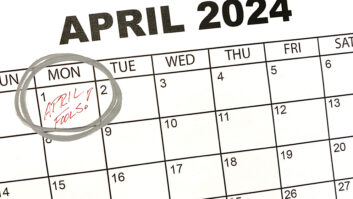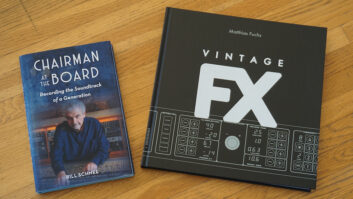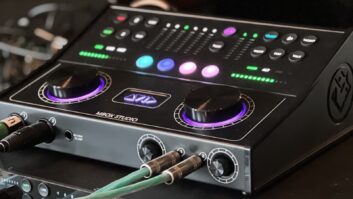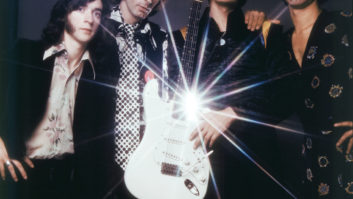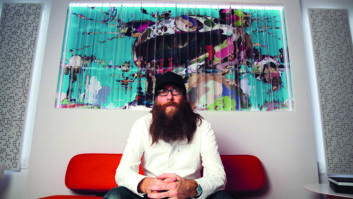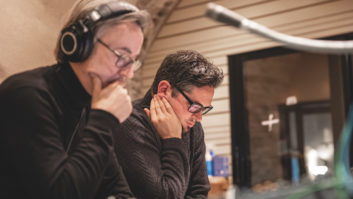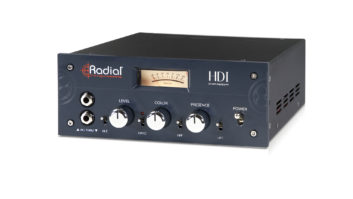Released in November ’98, The John Lennon Anthology is a magnificent piece of work-a four-disc set that captures the depth and breadth of Lennon’s post-Beatles work, offers unreleased rarities by the truckload and even works as an audio biography of the last decade of Lennon’s life. Among the 95 tracks are primitive, bare-bones home recordings of some of Lennon’s best songs; alternate takes that have been remixed for the box; a few live tracks; snippets from television performances; studio banter between Lennon and Phil Spector; and various song fragments that show different sides of Lennon’s personality-his humor, his sensitivity, the rawness of his emotions.
The set was four years in the making and was co-produced by Yoko Ono and Rob Stevens, a New Yorker who has worked on a number of recording projects with Yoko over the past 13 years, including her most recent CD, Rising; the reissue of 11 of her solo albums; and the Plastic Ono Band’s Live Peace in Toronto. Stevens’ credits also include mixing and/or production duties with such diverse artists as Herbie Hancock, Africa Bambaataa, Bill Laswell and the Red Hot Chili Peppers. A confirmed Beatles/Lennon fan years before he had any professional association with the music, Stevens describes working on the Lennon box as a “dream project. It was a great place to be for four years,” he says with a chuckle. In mid-November I talked to Stevens about putting together this historic anthology.
One of the first things I noticed about the set is that John’s vocals are so much more out front than they were on a lot of his solo albums. I could never figure out why he insisted on burying that glorious voice of his.
I agree. That was a conscious decision not to use as much on his voice when we were doing mixes. Both Yoko and George Martin have said that John hated the sound of his voice and he would look for any gimmick-whether it was a flange, a slap or a reverb-to help his voice. If you go through his solo albums, you can see that the ones where he used outside producers-like his first two were co-produced with Yoko and Phil Spector-his voice is more front and center. Then you go to Walls and Bridges and Rock ‘N Roll, where he was the sole producer, and you can hear the voice dug deeper into the mix. On Rock ‘N Roll, you can barely even hear his voice. So on this set, particularly on the Walls and Bridges and Rock ‘N Roll outtakes, I wanted the voice to be more prominent. Two of my favorite outtakes on the anthology are “Be Bop A Lula” and “Nobody Loves You When You’re Down and Out,” because for the first time the starkness of his singing is evident for everybody to hear.
I also wondered if John liked all that slap on his voice because his musical heroes, such as Gene Vincent, did it on their records.
I think that’s probably got a great deal to do with it, at least in the case of the Rock ‘N Roll record-“I want to sound like that.” Because you’ve got to remember that when you cut through the myth that was John, there was a kid there who loved rock ‘n’ roll. Between takes he was always breaking into old rock ‘n’ roll songs.
Was The Beatles’ Anthology series a reference point for you in putting this box set together?
Not really, no. It actually came out after I started working on the Lennon anthology. Formally, I was hired in 1994 to begin screening about 2,000 hours of John’s material. Those came in all shapes and sizes-cassettes, 8-tracks, 4-tracks, 16-tracks.
I don’t suppose they were all in one place.
Of course not! [Laughs] The cassettes were Yoko’s archives. EMI had the Plastic Ono Band albums over at Abbey Road, and they made digital safeties and sent them to me. Then there were about 600 hours of tapes from Walls and Bridges, Rock ‘N Roll and Mind Games. In 1988, I was sent down to the basement of the building where the Record Plant in New York used to be, and those tapes were sitting down there amid the mold and the mildew, and I catalogued them prior to this project. I’d say about 75 percent of all the tapes were uncatalogued before I got them, so I ended up creating a database and about 1,500 pages of paperwork with the listings and my initial reactions and second reactions; Yoko’s reactions.
To have Yoko trust me to be the initial screener was a huge honor, and it was a little frightening, too.
How much of it had she heard?
Well, she had participated in most of it. She was very active in his sessions. When you listen to the home cassettes, you can sometimes hear her in the background or you can hear John asking her things before or after the take. You hear her laughing, even singing a harmony here and there. So she lived it. I think it would have been unkind to ask her to go through those 2,000 hours with a lost partner. I listened to everything, and once I whittled it down to about 50 hours I started to present material to her.
Was there anything that wasn’t retrievable?
No, everything was either bakeable or the cassettes I cleaned up using the Cedar system. The Cedar was so good it was scary-you’d be amazed at some of the “before” and “after” tapes. I had some tapes that sounded like there was no way to make them listenable. But the algorithms in the Cedar can recognize the difference between noise and music so astutely, you can clean it right up.
There was one song-John’s acoustic version of “New York City”-that I actually bootlegged off a bootleg because the master is gone: Over the years Yoko has had some stuff stolen from her. So I took that and I cleaned it up. By the way, I felt no guilt about bootlegging the bootleg. [Laughs]
Not everything sounds perfect. When you go from a TV performance to a multitrack, you’re going to hear a difference. But that’s part of the set’s charm. The nature of the material and the nature of the project was not so much hi-fi as it was high emotion.
You did most of your mixing at Quad Recording on the SSL 9000 J?
Yes. Initially, we put the tapes up on a variety of consoles-old and newer Neves, some older E Series and G Series SSLs-and out of them we got a variety of qualities. We got warmth on some of them, we got clarity on others. The J gave me both, so we stuck with that. We used Studio A at Quad for maybe 90 percent of the mixes. That room felt like home to us. There ended up being about 50 mixes on the set.
What monitors did you use?
About 80 percent of the mixes were done on my KRKs-700 Series-and the rest I mixed on the new Mackies, which I got near the end of the project. Those were good for some of the low, low bottom definition. There wasn’t a whole lot of outboard gear used. I used some tape slap, some digital delay. Often John and his engineers would print their own tape slap. There might be tape slap at 7 11/42 and tape slap at 15, and I would bring up whatever seemed to work but usually not to the degree that they themselves might have brought it up.
I ended up doing very simple, musical mixes-fully EQ’d, maybe a little bit of reverb, very little adulterance on John’s voice. Presented as if you were there in the room as it happened. If you listen to Double Fantasy, that’s where John was heading. The voice is much clearer, and it’s mixed up more.
In a sense you were working as both a historian and a fan on this project. You wanted the set to have archival value, but it also had to appeal to the fans.
That’s right. That was something I was aware of. I think Yoko and I each fulfilled functions that the other could not fulfill. She was John’s partner in life, in art and in work. I was a devout Lennon fan. Not a fanatic mind you-a fanatic would probably think you should put on the sound of John brushing his teeth in the morning. [Laughs] But I could provide Yoko with the viewpoint of someone who had loved John’s work all my life and wanted to hear this, wanted to hear that, didn’t want to hear too much of this or too much of that.
And I have to give her a lot of credit, because she encouraged the dialog of difference. There were times when she didn’t want something out and I’d say, “Yoko, as a fan, and not as someone who simply wants to scrape the bottom of the barrel, would you consider looking at this track from this angle?” We didn’t always agree, and in the end I would defer to her, but she was open and would try to look at it from the perspective I was presenting.
I think it was a good decision not to overdo the between-songs chatter. What’s there definitely augments the set, but it doesn’t really intrude on the music.
As a listener, I didn’t want there to be too many places where after the first couple of times of being charmed or humored by something I’d want to then skip by it each time. Yoko was sensitive to that also.
I really love the studio conversations between John and Phil Spector, because they show what made their peculiar combination of personalities work. John’s messing around, messing with Phil, and Phil humors him but is still driving the session so something actually gets done.
Right. Who else is going to be able to keep John Lennon in line and say, “Yeah, John, you can do that, but only after you do this task”?
I think the greatest revelation for me was how good Disc 2 is-the political material from New York City. At the time I never really got into Sometime in New York City. It seemed sort of trite and obvious. But the way it’s presented here, as another epoch in Lennon’s life, it has more strength and resonance.
It’s funny you should say that, because I also wasn’t so much into the New York City period. With the exception of “Woman Is the Nigger of the World,” that album sort of passed me by, and I kind of jumped from Imagine to Mind Games. So it was surprising to me to really get into that period. I think it holds up pretty well, actually. There’s a lot of spirit in the songs, and like you say, it’s a specific period of his work, so it’s interesting in that way.
Interestingly, the first sequence we did on that particular disc-and Yoko is notorious for sequencing and resequencing until it feels exactly right-ended up being pretty close to what eventually went on the set. And that’s the only one of the discs that didn’t go through maybe 15 sequence permutations.
Can you talk about that process a little more?
I began by presenting her with some of my selections. And it was very difficult at first because the nature of this kind of beast is that you not only show the songs themselves, but you play a little bit of what happened before the take and what happened after the take. And invariably she’s there. And that was difficult to go back there and hear so much of this because he sounds so alive; he’s really there on these tapes. But as time went on, her resilience built up to the point where she was at it for 12 or 16 hours a day, seven days a week. The last three months on the project it was nearly around the clock, with the two of us tossing sequencing options back and forth, deciding on which versions to use. We took it up to the last possible minute.
There’s a version of “Only You” [intended for a Ringo Starr album] with John singing the guide. And all I had until two days before I was going to master was a crummy bootleg version of that. And then Richard Perry, the producer, bless his soul, discovered that he had the multi in his storage room. So I got it on the Saturday morning before the Monday I had to master. We transferred it, I did a mix that day, Yoko commented on Sunday, I fixed it Monday morning at 10 a.m. and at 11 a.m. it was mastered.
Generally speaking, how was the quality of the studio recordings?
They were amazing. A lot of great engineers were involved-Shelly Yakus, Roy Cicala. Jimmy Iovine, who became a great producer and now runs Interscope Records, was Shelly’s assistant. At one point you can hear Shelly telling Jimmy to adjust John’s gobo. Double Fantasy was Jack Douglas. That to me was a record-maker’s record. If that came out today it would still sound modern. The sound and the depth of the sound on Walls and Bridges were astounding.
Is that because of the room where it was recorded?
I don’t think it’s so much the Record Plant as it was Shelly’s knowledge of the drums he was using and, of course, the players. A good player like Jim Keltner knows how to hit the drums so they sound great on tape. They are so rich and deep on tape. If I had a different sense of ethics than I do, I’d be sampling those snare drums left and right. [Laughs] If you listen to “Nobody Loves You When You’re Down and Out,” you can hear what I’m talking about.
In terms of the players, he had Tony Levin and Jim Keltner and Jesse Ed Davis, David Spinoza. These weren’t just great players; they were guys who knew how to work with each other, and they clearly knew how to get great sounds in the studio.
I always thought John was underrated as a guitarist.
I agree. He was much better than is acknowledged, if you’re listening for the feel of a song. It’s not like his tuning was impeccable or the timing was impeccable, but when I removed his guitar from some of the mixes, even though they sounded slicker in terms of the playing, you lost a lot of the feel, because he brought an earthiness to it that was really part of how he intended the song. People talk about “songwriter’s guitar” or “songwriter’s piano.” I’d put John’s work in that category.
When you went back to the masters for actual mixing, did you eliminate any parts-a third guitarist, a stray maraca?
Yes, there were some choices made along those lines. In most cases, when I listened to the tapes I could tell what was an overdub and what wasn’t by listening to the nature of the leakage-whether it came from headphones or from the room around the player. And there were times when I would remove some of the overdubs to get down to the initial tracking session. There were never any extractions where, say, I’d go down to just John and his guitar when there was actually a whole band playing around him. If there was a band, you hear a band. But if there were three guitar players, you might only hear two of them. That was to keep the focus on the raw John doing the song in a more pure, less produced form.
By the end of the project you must have felt as though you got to know John well, listening to him in the studio and at home in so many creatively intimate moments.
It would be presumptuous of me to say that I really got to know him, but I did get a sense of what he was like. By the end, I felt like I knew what it would be like to be in the studio with him. I had sense of what it would be like to work with someone whose brain was firing on all cylinders so much of the time.
On a project like this you can feel like it’s a job well done, but there’s a bittersweetness at the end. You finish a normal record with a living, breathing artist and you feel celebratory and relieved and you have that feeling of moving on, which is also a little sad because when you make a record with a group, you sort of become like family for a while. And in this case there was Yoko, but no John, to share it with, and there was bittersweetness on her part that mine was no match for, obviously. But it was a challenge and privilege to work on it; a once-in-a-lifetime opportunity I wouldn’t trade for anything.
